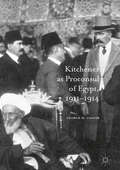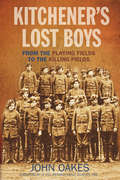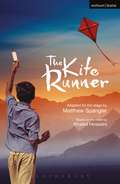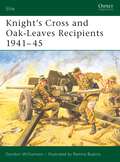- Table View
- List View
Kitchener: The Road to Omdurman and Saviour of the Nation
by Rev John PollockWhen the Great War broke out, Kitchener, with the foresight lacking in many of his contemporaries, insisted that it would last at least three years and that he must raise an army of 3 million men. This began with an immediate recruitment of 100,000 volunteers, and the familiar poster campaign image of him with the line "Your country needs you".Major battles and initiatives of the Great War are recreated in a dramatic narrative history which does justice to Kitchener's masterly planning. This superb double volume biography will transform our view of Kitchener and the First World War.
Kitchener as Proconsul of Egypt, 1911-1914
by George.H. CassarThis book covers the tenure of Kitchener as Proconsul in Egypt in the years preceding the First World War. Based mostly on unpublished sources – including government records and private papers – it not only fills a gap in the life and career of Kitchener, the most famous soldier in Britain since Wellington, but it also deals with an important but practically unknown period in Egyptian history. George Cassar shows Kitchener to be an ardent imperialist, but one who had a sense of responsibility to the country he governed. Exchanging his field marshal’s uniform for the dress of a statesman, he arrived in Egypt when British prestige was at a low point on account of his predecessor’s policies. He restored political stability, created conditions that bolstered the economy, and introduced a wave of reforms. Kitchener as Proconsul of Egypt, 1911-1914 reveals how Kitchener’s interest extended beyond Egypt, and how throughout these years he worked quietly to prepare the ground in an attempt to create an Arab Empire under Britain’s suzerainty.
The Kitchener Enigma: The Life and Death of Lord Kitchener of Khartoum, 1850-1916
by Trevor RoyleIn this critically acclaimed biography, now fully updated, Royle revises Kitchener’s latter-day image as a stern taskmaster, the ultimate war lord, to reveal a caring man capable of displaying great loyalty and love to those close to him. New light is thrown on his Irish childhood, his years in the Middle East as a biblical archaeologist, his attachment to the Arab cause and on the infamous struggle with Lord Curzon over control of the army in India. In particular, Royle reassesses Kitchener’s role in the Great War, presenting his phenomenally successful recruitment campaign – ‘Your Country Needs You’ – as a major contribution to the Allied victory and rehabilitating him as a brilliant strategist who understood the importance of fighting the war on multiple fronts.
Kitchener's Last Volunteer: The Life of Henry Allingham, the Oldest Surviving Veteran of the Great War
by Dennis Goodwin Henry AllinghamHenry Allingham is the last British serviceman alive to have volunteered for active duty in the First World War and is one of very few people who can directly recall the horror of that conflict. In Kitchener's Last Volunteer, he vividly recaptures how life was lived in the Edwardian era and how it was altered irrevocably by the slaughter of millions of men in the Great War, and by the subsequent coming of the modern age.Henry is unique in that he saw action on land, sea and in the air with the British Naval Air Service. He was present at the Battle of Jutland in 1916 with the British Grand Fleet and went on to serve on the Western Front. He befriended several of the young pilots who would lose their lives, and he himself suffered the privations of the front line under fire.In recent years, Henry was given the opportunity to tell his remarkable story to a wider audience through a BBC documentary, and he has since become a hero to many, meeting royalty and having many honours bestowed upon him.This is the touching story of an ordinary man's extraordinary life - one who has outlived six monarchs and twenty-one prime ministers, and who represents a last link to a vital point in our nation's history.
Kitchener's Lost Boys: From the Playing Fields to the Killing Fields
by John OakesIn the early days of the First World War, Lord Kitchener made his famous appeal for volunteers to join the New Army. Man flocked to recruiting offices to enlist, and on some days tens of thousands of potential soldiers responded to his call. Men had to be at least eighteen years old to join up, and nineteen to serve overseas, but in the flurry of activity many younger boys came to enlist: some were only thirteen or fourteen. Many were turned away, but a lot were illegally signed up, and at least 250,000 under-age boys found themselves fighting for King and Country in the First World War. In this groundbreaking new book, John Oakes delves into the complex history of Britain's youngest Great War recruits. Focusing on a school cricket team, all eleven of whom volunteered, he reveals why boys joined up, what their experiences were and how they survived to endure a lifetime of memories. For those who didn't, an unknown grave awaited. In some cases, their mothers never knew what had become of their children.
Kitchener's Mob / Adventures of an American in the British Army (The World At War)
by James HallJames Norman Hall (22 April 1887 – 5 July 1951) was an American author best known for the novel Mutiny on the Bounty with co-author Charles Nordhoff. During World War I, Hall had the distinction of serving in the militaries of three Western allies: Great Britain as an infantryman and then flying for France and later the United States. James Hall begins his story of Kitchener and the men who fought with him on the Western Front as follows. "Kitchener's Mob" they were called in the early days of August 1914, when London hoardings were clamorous with the first calls for volunteers. The seasoned regulars of the first British expeditionary force said it patronisingly, the great British public hopefully, the world at large doubtfully. "Kitchener's Mob," when there was but a scant sixty thousand under arms with millions yet to come. "Kitchener's Mob" it remains to-day, fighting in hundreds of thousands in France, Belgium, Africa, the Balkans. (Excerpt from Wikipedia and Goodreads)
The Kite Runner (Modern Plays)
by Khaled Hosseini Matthew SpanglerI became what I am today at the age of twelve. I remember the precise moment, crouching behind a mud wall on a frigid winter day in 1975 . . . looking into a deserted alley. It's wrong what they say about the past, about how you can bury it, because the past claws its way out. I realize I've been looking into that alley for the last 26 years.Afghanistan is a divided country on the verge of war and two childhood friends are about to be torn apart. It's a beautiful afternoon in Kabul and the skies are full of the excitement and joy of a kite flying tournament. But neither Hassan or Amir can foresee the terrible incident which will shatter their lives forever.Khaled Hosseini's first and international best-selling novel has now been adapted into a stunning stage adaptation by Matthew Spangler.This edition was published for the production at Wyndham's Theatre, London, from 21 December 2016.
The Kite Runner: Based On The Novel By Khaled Hosseini (Modern Plays)
by Khaled Hosseini Matthew SpanglerI became what I am today at the age of twelve. I remember the precise moment, crouching behind a mud wall on a frigid winter day in 1975 . . . looking into a deserted alley. It's wrong what they say about the past, about how you can bury it, because the past claws its way out. I realize I've been looking into that alley for the last 26 years.Afghanistan is a divided country on the verge of war and two childhood friends are about to be torn apart. It's a beautiful afternoon in Kabul and the skies are full of the excitement and joy of a kite flying tournament. But neither Hassan or Amir can foresee the terrible incident which will shatter their lives forever.Khaled Hosseini's first and international best-selling novel has now been adapted into a stunning stage adaptation by Matthew Spangler.This edition was published for the production at Wyndham's Theatre, London, from 21 December 2016.
Kitson’s Irish War: Mastermind of the Dirty War in Ireland
by David BurkeThe British government has taken steps to halt the prosecution of soldiers responsible for the deaths of civilians in Northern Ireland, most of whom had no connection to paramilitary activities. These killings were part of a ruthless dirty war that commenced in 1970 when Brigadier Frank Kitson, a counter-insurgency specialist, was sent to Northern Ireland. Kitson had spent decades in Britain’s colonies refining old, and developing new, techniques which he applied in Northern Ireland. He became the architect of a clandestine war, waged against Nationalists while ignoring Loyalist atrocities. Kitson and his colleagues were responsible for: • The establishment of the clandestine Military Reaction Force (MRF) which carried out assassinations on the streets of Belfast of suspected IRA members; • The infiltration of Loyalist gangs which instigated a process of control and collusion that continued throughout the ‘Troubles’; • They unleashed the most violent elements of the Parachute Regiment [1 Para] to terrorise Nationalist communities which, they adjudged, were providing support for the Official and Provisional IRA; • Spreading black propaganda designed to undermine Republican but not Loyalist paramilitary groups; • Deployed psychological warfare techniques, involving the torture of internees; • Sent Kitson’s ‘Private Army’ – Support Company of 1 Para - to Derry where they perpetrated the Bloody Sunday massacre. The British Widgery and Saville inquiries did not hold Kitson and his elite troops accountable for Bloody Sunday. Kitson’s Irish War lays bare the evidence they discounted: Kitson’s role in the events leading up to and surrounding that massacre; evidence from a deserter from 1 Para who joined the IRA; a deceitful MI5 agent; a courageous whistle blower whom the British state tried to discredit, and much more, all of which points to a motive for the attack on the Bogside. This book unlocks the some of the key secrets of the Dirty War that the British government is still determined to cover-up.
Kitted Out: Style and Youth Culture in the Second World War
by Caroline YoungWhen war was declared in September 1939, young people around the world were expected to put on a uniform and fight in a conflict not of their making. They may have been dressed in regulation khaki or air force blue, or restricted by rationing, but driven by angst, patriotism and survival, they took every opportunity to express themselves by adapting their clothing. Away from the war their lives were shaped by swing music and its fashions, allowing individualism to flourish despite repression and offering a rebellious reaction to the fearful sound of jackboots marching in unison. It was a time of new identities, factions and hierarchies. From the British Tommies and the American GIs, to the ‘Glamour Boys’ of the RAF, the ‘Spitfire Girls’ of the ATA and members of the French Resistance, Kitted Out is a fresh take on the history of the Second World War through a fashionable eye. The poignant and inspiring stories behind the uniforms, styles and self-expression in Britain, the United States, North Africa and occupied Europe will be painfully resonant to a new generation of young people.
Kitty’s War
by Terri Nixon1917. Kitty Maitland has found a safe and welcoming home at Dark River Farm, Devon, and is finally beginning on a path to recovery after her terrible ordeal in Flanders … until the arrival of two very different visitors threatens to rip her new little family apart.
KL: A History of the Nazi Concentration Camps
by Nikolaus WachsmannIn March of 1933, a disused factory surrounded by barbed wire held 223 prisoners in the town of Dachau. By the end of 1945, the SS concentration camp system had become an overwhelming landscape of terror. Twenty-two large camps and over one thousand satellite camps throughout Germany and Europe were at the heart of the Nazi campaign of repression and intimidation. The importance of the camps in terms of Nazi history and our modern world cannot be questioned. Dr Nikolaus Wachsmann is the first historian to write a complete history of the camps. Combining the political and the personal, Wachsmann examines the organisation of such an immense genocidal machine, whilst drawing a vivid picture of life inside the camps for the individual prisoner. The book gives voice to those typically forgotten in Nazi history: the 'social deviants', criminals and unwanted ethnicities that all faced the terror of the camps. Wachsmann explores the practice of institutionalised murder and inmate collaboration with the SS selectively ignored by many historians. Pulling together a wealth of in-depth research, official documents, contemporary studies and the evidence of survivors themselves, KL is a complete but accessible narrative.
Klop: Britain's Most Ingenious Secret Agent
by Peter DayKlop Ustinov was Britain's most ingenious secret agent, but he wasn't authorised to kill. Instead, he was authorised to tell tall tales, bemusing and beguiling his enemies into revealing their deepest, darkest secrets. From the Russian Revolution to the Cold War, he bluffed and tricked his way into the confidence of everyone from Soviet commissars to Gestapo Gruppenführer. In Klop: Britain's Most Ingenious Secret Agent, journalist Peter Day brings to life a man descended from Russian aristocrats and Ethiopian princesses but who fancied himself the perfect Englishman. His codename was U35 but his better-known nickname 'Klop' meant 'bedbug', a name given to him by a very understanding wife on account of his extraordinary capacity to hop from one woman's bed to another in the service of the King. Frequenting the social gatherings of Europe in the guise of innocent bon viveur, he displayed a showman's talent for entertaining (a trait his son, the actor Peter Ustinov, undoubtedly inherited), holding a captive audience and all the while scavenging secrets from his unsuspecting companions. Klop was masterful at gathering truth by telling a story; this is his.
Knife Edge: an epic and enthralling naval adventure from the master storyteller of the sea (The\royal Marines Saga Ser. #5)
by Douglas ReemanJanuary 1970, and the final chapter in the Blackwood history appears to have closed with the murder in Cyprus of Lieutenant-Colonel Mike Blackwood, and the subsequent sale of the ancestral home. Disillusioned and grieving for his distinguished father, Lieutenant Ross Blackwood believes there is no future for him in the Corps. The Royal Marines have been reduced in strength, and their role in a modern world, after so splendid a tradition, diminished to policing and paperwork.But Ross remains a Blackwood and a Royal Marine, and the loyalty and dedication of a Blackwood to the Corps sustain him from vicious guerilla warfare in Malaysia through the moral and political minefields of Northern Ireland, where one man's terrorist is another's patriot, to the South Atlantic, and a conflict as bloody as it is unpredictable.And he learns, as every Blackwood has before him, that jungle or moor, insurrection or invasion, mere courage is not enough. Survival and victory balance on the knife edge of destiny.
The Knife Man: Blood, Body Snatching, And The Birth Of Modern Surgery
by Wendy MooreWINNER OF THE MEDICAL JOURNALISTS' OPEN BOOK AWARD 2005Revered and feared in equal measure, John Hunter was the most famous surgeon of eighteenth-century London. Rich or poor, aristocrat or human freak, suffering Georgians knew that Hunter's skills might well save their lives but if he failed, their corpses could end up on his dissecting table, their bones and organs destined for display in his remarkable, macabre museum. Maverick medical pioneer, adored teacher, brilliant naturalist, Hunter was a key figure of the Enlightenment who transformed surgery, advanced biological understanding and even anticipated the evolutionary theories of Darwin. He provided inspiration both for Dr Jekyll and Dr Dolittle. But the extremes to which he went to pursue his scientific mission raised question marks then as now.John Hunter's extraordinary world comes to life in this remarkable, award-winning biography written by a wonderful new talent.
The Knight Who Saved England: William Marshal and the French Invasion, 1217 (General Military Ser.)
by Richard BrooksIn 1217 England was facing her darkest hour, with foreign troops pillaging the country and defeat close at hand. But, at the battle of Lincoln, the seventy-year-old William Marshal led his men to a victory that would secure the future of his nation. Earl of Pembroke, right-hand man to three kings and regent for a fourth, Marshal was one of the most celebrated men in Europe, yet is virtually unknown today, his impact and influence largely forgotten. In this vivid account, Richard Brooks blends colourful contemporary source material with new insights to uncover the tale of this unheralded icon. He traces the rise of Marshal from penniless younger son to renowned knight, national hero and defender of the Magna Carta. What emerges is a fascinating story of a man negotiating the brutal realities of medieval warfare and the conflicting demands of chivalric ideals, and who against the odds defeated the joint French and rebel forces in arguably the most important battle in medieval English history – overshadowing even Agincourt.
The Knight Who Saved England: William Marshal and the French Invasion, 1217
by Richard BrooksIn 1217 England was facing her darkest hour, with foreign troops pillaging the country and defeat close at hand. But, at the battle of Lincoln, the seventy-year-old William Marshal led his men to a victory that would secure the future of his nation. Earl of Pembroke, right-hand man to three kings and regent for a fourth, Marshal was one of the most celebrated men in Europe, yet is virtually unknown today, his impact and influence largely forgotten. In this vivid account, Richard Brooks blends colourful contemporary source material with new insights to uncover the tale of this unheralded icon. He traces the rise of Marshal from penniless younger son to renowned knight, national hero and defender of the Magna Carta. What emerges is a fascinating story of a man negotiating the brutal realities of medieval warfare and the conflicting demands of chivalric ideals, and who against the odds defeated the joint French and rebel forces in arguably the most important battle in medieval English history – overshadowing even Agincourt.
A Knights Bridge Christmas: Christmas At Carriage Hill Bonus Story (Swift River Valley #5)
by Carla NeggersNew York Times bestselling author Carla Neggers celebrates the joy and romance of Christmas in New England
Knight's Cross and Oak-Leaves Recipients 1939–40 (Elite #114)
by Ramiro Bujeiro Gordon WilliamsonIn 1939 a new grade in the Iron Cross series was introduced, the Knight's Cross of the Iron Cross (Ritterkreuz des Eisernen Kreuzes). It was awarded for a variety of reasons, from skilled leadership to a single act of extreme gallantry, and was bestowed across all ranks, grades, and branches of service. As the war progresed, further distinctions were created for bestowal on existing winners, namely Oak-Leaves (Eichenlaub); Oak-Leaves with Swords (Eichenlaub und Schwertern); and Oak-Leaves with Swords and Diamonds (Eichenlaub, Schwerter und Brillanten). This book, the first in a sequence of four, covers winners of the Knights Cross and the Oak-Leaves distinction in the period 1939-40.
Knight's Cross and Oak-Leaves Recipients 1939–40 (Elite #114)
by Gordon WilliamsonIn 1939 a new grade in the Iron Cross series was introduced, the Knight's Cross of the Iron Cross (Ritterkreuz des Eisernen Kreuzes). It was awarded for a variety of reasons, from skilled leadership to a single act of extreme gallantry, and was bestowed across all ranks, grades, and branches of service. As the war progresed, further distinctions were created for bestowal on existing winners, namely Oak-Leaves (Eichenlaub); Oak-Leaves with Swords (Eichenlaub und Schwertern); and Oak-Leaves with Swords and Diamonds (Eichenlaub, Schwerter und Brillanten). This book, the first in a sequence of four, covers winners of the Knights Cross and the Oak-Leaves distinction in the period 1939-40.
Knight's Cross and Oak-Leaves Recipients 1941–45 (Elite)
by Gordon WilliamsonThe remarkable early successes of the armed forces of the Third Reich prompted the decision that the supreme decoration for personal valour or outstanding leadership – the Knight's Cross of the Iron Cross – was insufficient. To mark further acts of gallantry a new distinction was created in June 1940: the Oak-Leaves clasp. Further decorations in the form of the Swords and, finally, the Diamonds were added. This second title in our series describes and illustrates a selection of recipients of the Knight's Cross and Oak-Leaves between 1941 and early 1944, when the Wehrmacht was engaged on all fronts, as well as at sea and in the air.
Knight's Cross and Oak-Leaves Recipients 1941–45 (Elite)
by Gordon WilliamsonThe remarkable early successes of the armed forces of the Third Reich prompted the decision that the supreme decoration for personal valour or outstanding leadership – the Knight's Cross of the Iron Cross – was insufficient. To mark further acts of gallantry a new distinction was created in June 1940: the Oak-Leaves clasp. Further decorations in the form of the Swords and, finally, the Diamonds were added. This second title in our series describes and illustrates a selection of recipients of the Knight's Cross and Oak-Leaves between 1941 and early 1944, when the Wehrmacht was engaged on all fronts, as well as at sea and in the air.
Knight's Cross, Oak-Leaves and Swords Recipients 1941–45 (Elite #133)
by Ramiro Bujeiro Gordon WilliamsonOn 21 June 1941, as the Wehrmachtstormed forward across the frontiers of the Soviet Union, Hitler instituted a new higher grade of the Knight's Cross decoration for gallantry and leadership: the silver clasp of the Oak-Leaves with Swords. It would be awarded to only 159 men of the approximately 15 million who served in the German armed forces during World War II. This third in a sequence of four titles describes and illustrates a selection of the recipients: from much-wounded front line infantry officers, to Hitler's 'brother-in-law'; from a sergeant pilot fighter ace, to the commanding general of the greatest tank force ever gathered on the Russian Front.
Knight's Cross with Diamonds Recipients: 1941–45 (Elite #139)
by Ramiro Bujeiro Gordon WilliamsonOn 28 September 1941, Hitler instituted a new, supreme class of the Knight's Cross decoration for gallantry and leadership: the Oak-Leaves with Swords and Diamonds. This award would be presented to only 28 soldiers, sailors and airmen, out of the approximately 15 million who served in the German armed forces. This title describes and illustrates all 28 of those men from fighter aces and U-boat commanders, to the youngest generals in the Wehrmacht, and field marshals in command of army groups – and including one officer for whom Hitler had to invent a literally unique award that set him apart even among the 'Diamond-bearers'.
Knight's Cross with Diamonds Recipients: 1941–45 (Elite #139)
by Ramiro Bujeiro Gordon WilliamsonOn 28 September 1941, Hitler instituted a new, supreme class of the Knight's Cross decoration for gallantry and leadership: the Oak-Leaves with Swords and Diamonds. This award would be presented to only 28 soldiers, sailors and airmen, out of the approximately 15 million who served in the German armed forces. This title describes and illustrates all 28 of those men from fighter aces and U-boat commanders, to the youngest generals in the Wehrmacht, and field marshals in command of army groups – and including one officer for whom Hitler had to invent a literally unique award that set him apart even among the 'Diamond-bearers'.



















